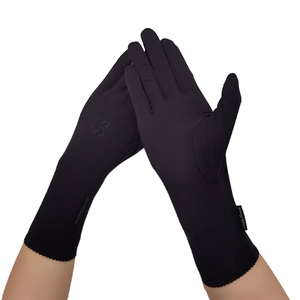
All categories
Featured selections
Trade Assurance
Buyer Central
Help Center
Get the app
Become a supplier

(7951 products available)

















































compression gloves play a crucial role in ensuring the safety of individuals across various industries. Designed to protect the hands and arms from potential hazards, these products are essential in workplaces where risks of cuts, abrasions, chemical exposure, and impact injuries are prevalent. compression gloves are made from a wide range of materials, including leather, rubber, and synthetic fibers, each offering unique protective qualities. As safety standards evolve, the development of compression gloves continues to advance, integrating innovative technologies to enhance comfort, durability, and overall protection. Understanding the different types and their specific applications is vital for selecting the right equipment for any setting.
There is a diverse array of compression gloves available, each tailored to address specific safety needs. Common types include cut-resistant gloves, chemical-resistant gloves, impact-resistant gloves, and thermal gloves. Cut-resistant gloves are typically made from materials like Kevlar or stainless steel mesh, providing exceptional protection against sharp objects. Chemical-resistant gloves are crafted from materials such as nitrile or neoprene, offering a barrier against hazardous substances. Impact-resistant gloves often feature reinforced knuckles and padding to absorb shock and prevent injuries in high-impact environments. Thermal gloves are designed to insulate against extreme temperatures, utilizing materials like wool or Thinsulate to maintain warmth. Understanding these different types of compression gloves allows for informed decision-making in selecting the appropriate protection for specific tasks.
compression gloves are engineered to provide a variety of protective functions, ensuring user safety without compromising performance. Key features include enhanced grip, dexterity, and durability. Many gloves incorporate textured surfaces or coatings to improve grip, reducing the risk of objects slipping from hands. Dexterity is crucial, especially in tasks requiring precision, so compression gloves are designed to allow for flexibility and ease of movement. Durability is another critical aspect, with reinforced seams and abrasion-resistant materials ensuring longevity and reliability. Some compression gloves also offer additional features such as touchscreen compatibility, moisture-wicking properties, and antibacterial treatments, enhancing user comfort and convenience.
The selection of materials for compression gloves is pivotal in determining their effectiveness and suitability for various applications. Leather is a traditional choice, known for its durability and comfort, making it ideal for heavy-duty tasks. Rubber and latex provide excellent chemical resistance, often used in environments where exposure to hazardous substances is a concern. Synthetic fibers like nylon and polyester offer lightweight and breathable options, suitable for prolonged wear. Advanced materials such as Dyneema and Spectra are increasingly used for their high tensile strength and cut resistance. The integration of these materials into compression gloves ensures a balance between protection, comfort, and practicality.
Choosing the appropriate compression gloves involves assessing the specific risks associated with the task at hand. Consider factors such as the nature of hazards, duration of exposure, and required dexterity. For tasks involving sharp objects, prioritize cut-resistant gloves with materials like Kevlar. In chemical handling, opt for gloves with superior chemical resistance, ensuring compatibility with the substances encountered. Impact-intensive environments necessitate gloves with reinforced padding and shock absorption capabilities. Additionally, evaluate the fit and comfort of compression gloves, as prolonged wear can lead to fatigue if not properly fitted. It's also important to consider any additional features that may enhance usability, such as touchscreen compatibility or moisture-wicking properties, to ensure optimal performance in various conditions.
Selecting the right compression gloves for hand and arm protection requires careful evaluation of various factors. The primary consideration is the specific hazards present in the workplace or task environment. For example, if the work involves handling sharp objects, cut-resistant materials are essential. Similarly, if exposure to chemicals is a concern, chemical-resistant features are crucial. Beyond the material, consider the ergonomic design and fit of the compression gloves, which can significantly impact comfort and usability. Additionally, the level of dexterity required for the task should influence the choice, ensuring that the compression gloves allows for sufficient movement while providing adequate protection.
When selecting compression gloves, it's essential to focus on both performance and comfort. Advanced technologies are integrated into many designs to enhance these aspects. Features like moisture-wicking properties can help maintain comfort during prolonged use, while reinforced seams and durable materials ensure longevity. The balance between protection and ease of movement is vital, especially for tasks requiring precision and control. Many compression gloves options offer added functionalities such as touchscreen compatibility, which can be beneficial in modern work environments where digital interaction is frequent. Evaluating these features helps ensure that the chosen compression gloves meets the specific demands of the task while maintaining user comfort.
With growing awareness around sustainability, it's important to consider the environmental impact of compression gloves. Manufacturers are increasingly using eco-friendly materials and processes to minimize their carbon footprint. Options such as biodegradable or recyclable materials are available, allowing users to make environmentally conscious choices. Additionally, the durability and lifespan of compression gloves can contribute to sustainability by reducing the need for frequent replacements. Understanding the lifecycle of the materials used in compression gloves can inform decisions that align with environmental goals, ensuring both safety and ecological responsibility.
Common materials used in compression gloves include leather, rubber, and synthetic fibers like Kevlar and Dyneema. Each offers distinct protective qualities suited to different hazards, such as cuts, chemicals, and impact.
To determine the right size for compression gloves, measure your hand and arm dimensions carefully, considering length, width, and circumference. Fit is crucial for both safety and comfort, so consult sizing charts provided by manufacturers.
Yes, many compression gloves options are designed with touchscreen compatibility, allowing users to interact with digital devices without removing protection. Look for gloves with conductive materials in the fingertips.
Maintenance requirements for compression gloves vary by material. Leather may need conditioning, while rubber and synthetic fibers often require regular cleaning and inspection for wear and tear to ensure longevity and effectiveness.
Some compression gloves are specifically designed for extreme temperatures, using materials like Thinsulate or wool for insulation. It's important to select gloves that are rated for the temperature conditions they will be exposed to.